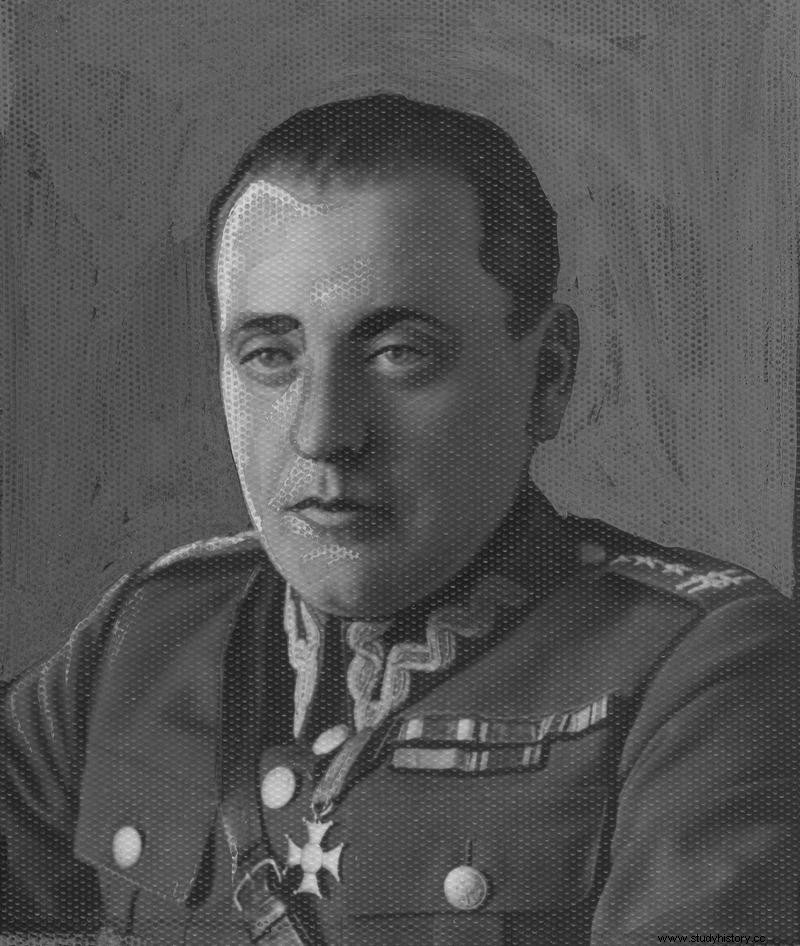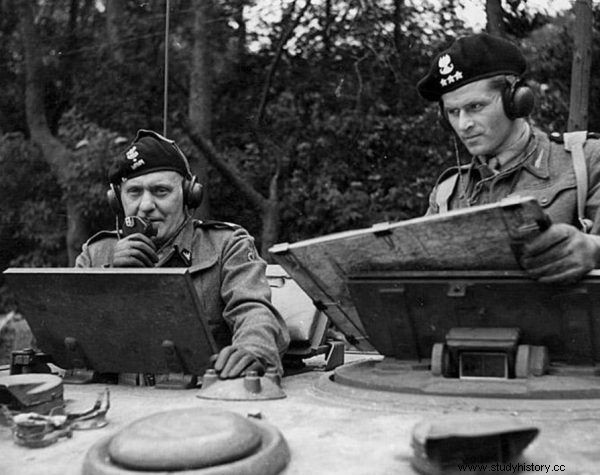Maczek's Pancerniacy was one of the most famous Polish units from the Second World War. At Falaise, they defeated the Germans, taking bloody retaliation for the September campaign. But this unit would not exist at all if not for the efforts of its commander. How did Maczek create the 1st Armored Division?
After losing the defensive war in 1939, Colonel Stanisław Maczek landed in Hungary with his fearless 10th Cavalry Brigade. However, he did not stay there for too long. On October 22, he checked in in Paris with the Commander-in-Chief - Władysław Sikorski.
In recognition of his merits, he was promoted to a brigadier general and was given the position of commandant of the Coētquidan camp, where the Polish Army in France was formed. In a short time he also began efforts to reactivate his formation, this time in the form of a light mechanized division.
Disappointed hopes
This plan was all the more realistic as most of his former subordinates were also already on the Seine. However, it was not until May 1940 - that is, after the invasion of the Germans - that the French agreed to create a Polish armored unit. The difficult situation at the front forced them to do so.
In the end, a combat group was formed from the separate subunits of the still defunct armored division, which was given the buzzy name of the 10th Armored Cavalry Brigade. Of course, its command was entrusted to General Maczek. The unit was directed to the front to Champagne, but its activity there was basically limited to covering the French retreating under German pressure.

In recognition of his merits, Maczek was promoted by the Commander-in-Chief to a general in France. In the photo, Stanisław Maczek was still a colonel.
The only bright spot during the battles of Polish tankmen on French soil was their capture of the town of Montbard on June 16, 1940. Ultimately, however, the brigade was encircled and the general was forced to disband it. He then ordered his soldiers to break through to the part of the country unoccupied by the Nazis, and from there to Great Britain, "the island of last hope" (he also got there).
In Scotland, the general initially took command of the 2nd Rifle Brigade, in which many of his former subordinates served. Also in England, he tirelessly made efforts to create a Polish armored division. As a result of these efforts, his unit was renamed the 10th Armored Cavalry Brigade.
However, he still had to wait for the real breakthrough. February 25, 1942 turned out to be an epochal day in the history of Polish armored forces. It was then that the Commander-in-Chief, Władysław Sikorski, gave the order to establish the Polish 1st Armored Division, headed by General Maczek.
Difficult beginnings
At the time of landing in France in early August 1944, the 1st Armored Division consisted of the staff, the 10th Armored Cavalry Brigade, the 3rd Motorized Rifle Brigade, the 10th Mounted Rifle Regiment (reconnaissance unit), four artillery regiments, a communications battalion, a sapper battalion and associated units. In total, it was over 16,000 soldiers, 381 tanks, 473 guns and about 4,000 motor vehicles.
Operationally, the division was part of the 2nd Corps of the 1st Canadian Army, subordinate to the 21st Army Group, commanded by General Bernard L. Montgomery. The Canadians (and thus the Polish unit) were assigned the task of taking the strike from the Caen area on the Falaise within the "Totalize" operation. The Allies hoped that this attack would break the deadlock - as they had made very little progress in the area since the Normandy invasion.
The offensive was scheduled for the night of August 7-8, 1944. The Polish 1st Division and the Canadian 4th Panzer Division were to advance frontally along a narrow corridor from Caen, on both sides of the road connecting the city with Falaise. However, Maczek had a lot of reservations about this concept.

General Maczek had justified objections to the Allied plan of the offensive in Normandy.
First of all, it deprived him of the initiative as a commander, thus severely restricting the possibility of the Polish troops to maneuver in the event of an aggravation of the situation. For this reason, the Allied plan exposed our division to heavy losses. The general himself was actually reduced to the role of the "messenger" giving orders. Maczek, who preferred to have a certain freedom, rebelled against this style of warfare. As he himself emphasized:
I have never liked moving me from point to point, embarrassing me with details of execution, dictating not always the best solution. A clearly set task, even if it is difficult, as long as it clearly defines what you want from me!
On the eve of the operation, the Polish general cautiously asked the commander of the 2nd Corps, Guy Simonds, to extend the designated 1st Armored Division of the attack line. This would make it much more difficult for the enemy to concentrate their fire while attacking. The Canadian categorically refused, however, and on August 8, Maczek's fears were fully confirmed.
Bloody battles under Falaise
When at 13.35 the tanks of our division went into battle, they came across a wall of fire of German artillery. Only one, the 2nd Panzer Regiment, lost 32 of the 36 Shermans sent to attack. The remaining units lost a total of 5 tanks. The attack of Poles and Canadians was temporarily stopped.
Over the next four days, individual units of the 1st Panzer Division fought fierce battles with the Nazis, but failed to break the enemy's well-organized defense. General Maczek was constantly watching over the course of these clashes. He analyzed reports coming from the battlefield on an ongoing basis. When deemed appropriate, he supported his own sub-units with reserve forces or artillery fire, and also approved or corrected the decisions of his subordinates.
On August 12, Polish tankers were sent to the reserve in order to replenish losses as well as ammunition, fuel and food. At that time, thanks to the successes of the American 15th Corps, there was an opportunity to surround the German troops in the Falaise area. The only escape route for the enemy troops was the gap between this city and Argentan. In view of this turn of events, the 1st Panzer Division was tasked with completing the encirclement; she had to hit the town of Trun and Chambois beyond, where she would connect with the Americans.
In a conversation with General Simonds, Maczek proposed his own action plan. He suggested that - in addition to the frontal attack on the above-mentioned towns - the hills lying to the east of them should also be captured. Years later, Colonel Franciszek Skibiński commented on the initiative of his then commander:
Maczek developed his own concept of the maneuver. He was gifted with a special talent. With one glance, he could see and assess the point of the terrain that was decisive for a given activity. Such a point, decisive for cutting off the line of the German retreat, was - apart from Chambois - the Mont Ormel hill complex (...). It consisted of two hills 262, north and south. The outlines of the hills were shaped like a club on the map. Maczek immediately called it "The Club".
Both points, crucial for the success of the operation, were seized by the Poles before the evening of August 19. Thus, about 70,000 enemy soldiers were housed in the cauldron at Falaise. Further fights of our division had the character of circular defense. From August 20, Maczek's armored personnel operated in isolation for two consecutive days. They were strongly pressed both from the inside (by German troops trying to get out of the encirclement at all costs) and from the outside (by the SS units coming to their aid).
Despite heavy losses, the general's subordinates remained in their posts until the arrival of Canadians and Americans. And although the Battle of Falaise did not lead to the complete annihilation of the German army, the Germans suffered huge losses at that time. The Polish division alone took over 5,000 prisoners and destroyed large amounts of equipment - including 55 tanks, 44 field guns and 38 armored cars. As it turned out later, it was the biggest battle of Maczek's tankmen on the Western Front.
***
You can read about the secret of the successes of our greatest leaders in the book "Polish gods of war" . The above text is an excerpt from the chapter devoted to Stanisław Maczek.
